Simulating Urban Growth Using the SLEUTH Model in a Coastal Peri-Urban District in China
Abstract
:1. Introduction
2. Methods and Procedures
2.1. Study Area
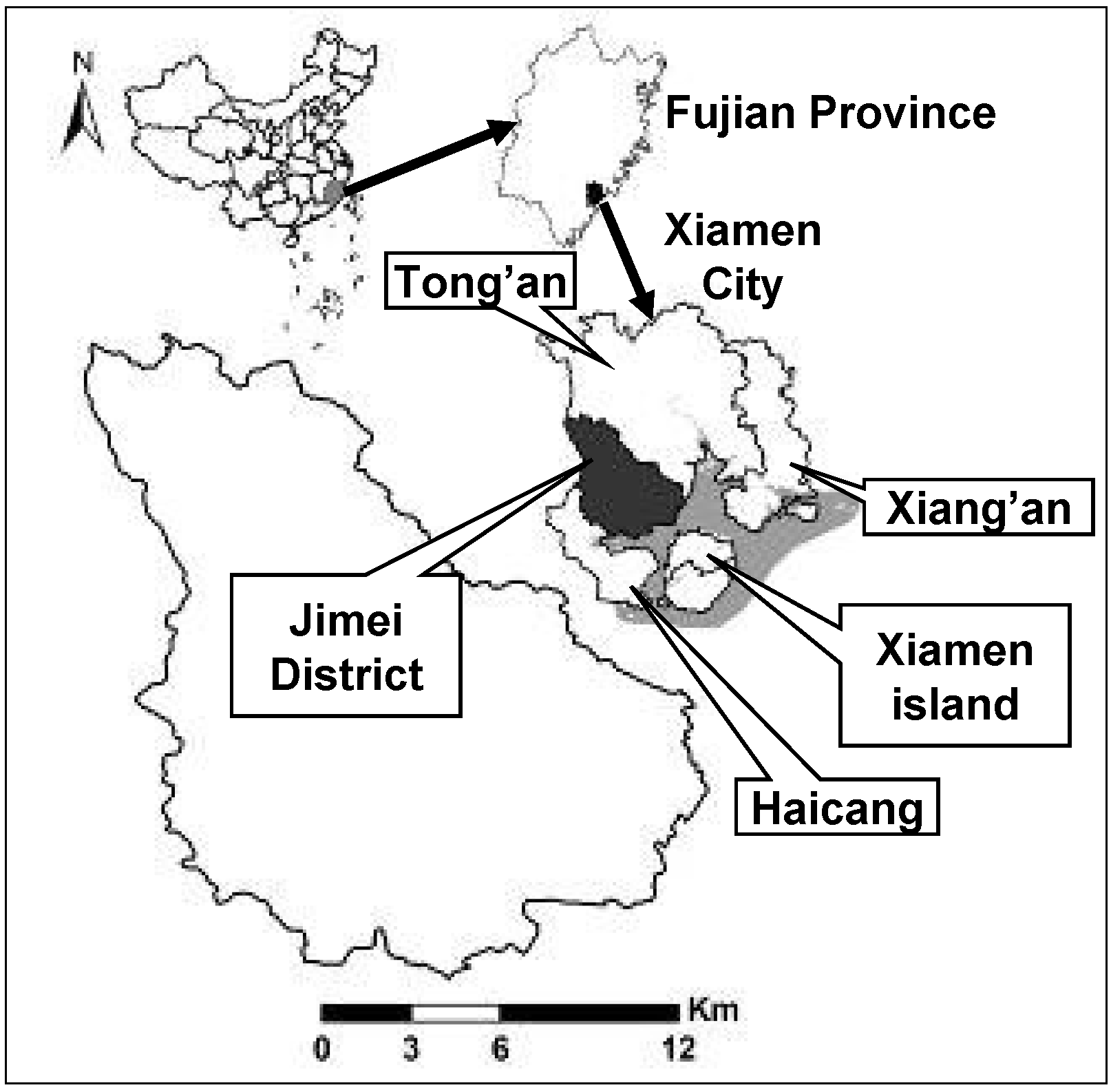
2.2. SLEUTH Model Description
2.3. Input Preparation
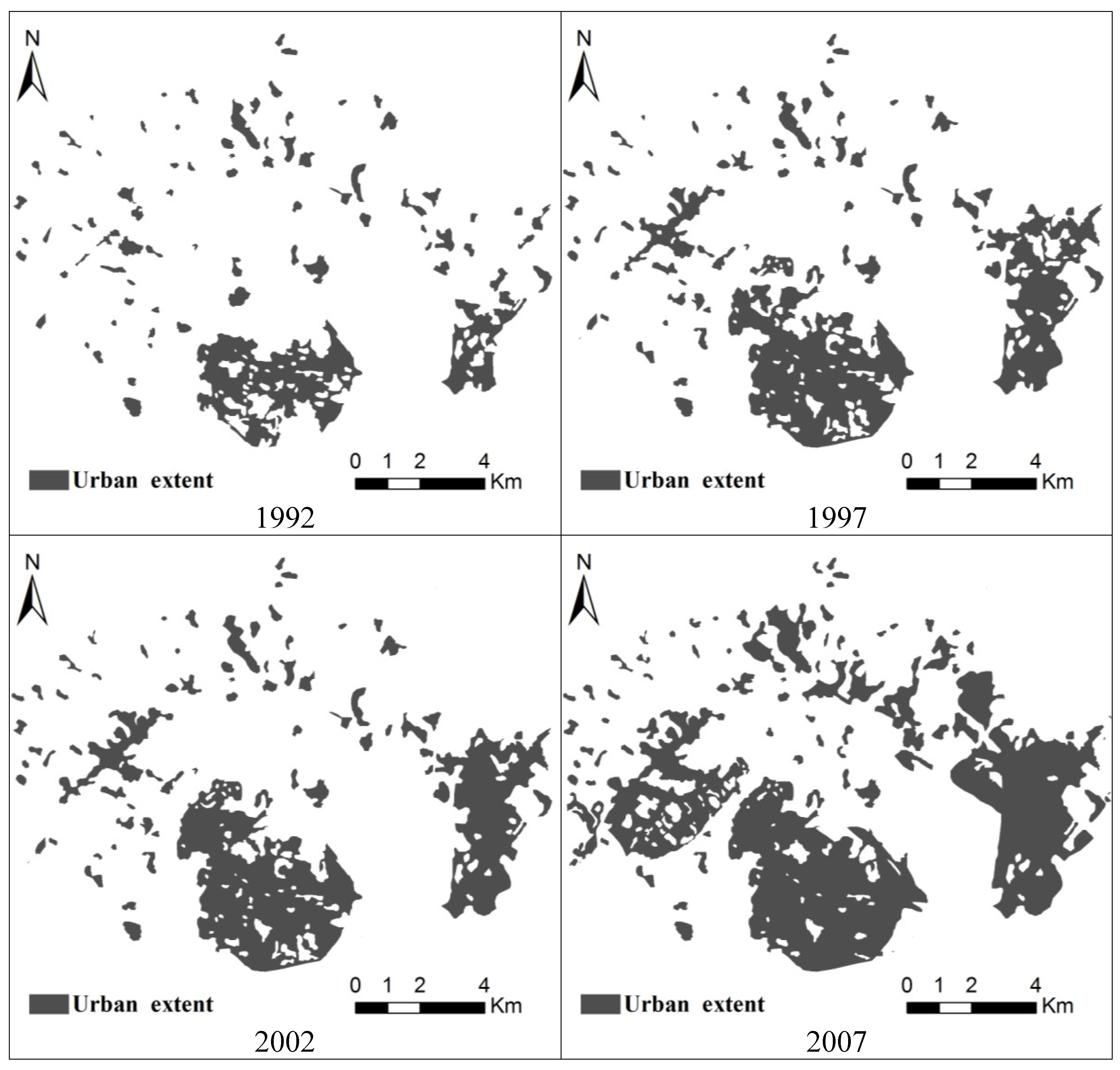
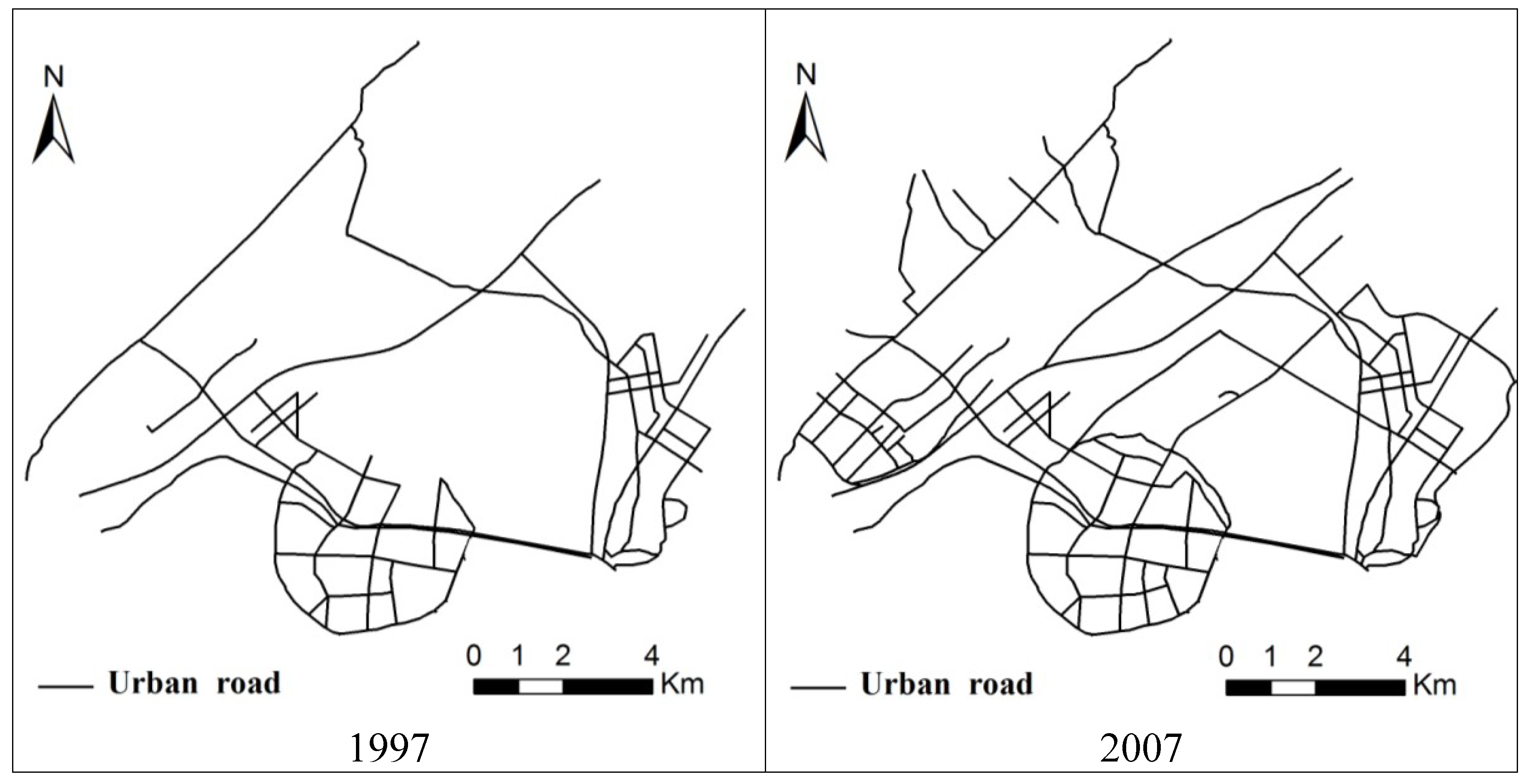
2.4. Model Calibration Procedures
| Index | Description |
|---|---|
| Product | A composite index which is the result of all scores multiplied together |
| Compare | Comparison of modeled final urban extent to real final urban extent |
| r2 population | Least square regression score of modeled urbanization compared with actual urbanization for control years |
| Edges r2 | Least square regression score for modeled urban edge count compared with actual urban edge count for control years |
| R2 clusters | Least square regression score for modeled urban clustering compared with known urban clustering for control years |
| Average Slope r2 | Least square regression of average slope for modeled urbanized cells compared with average slope of known urban cells for control years |
| Xmean r2 | Least square regression of average x values for modeled urbanized cells compared with average X values of known urban cells for control years |
| Ymean r2 | Least square regression of average y values for modeled urbanized cells compared with average y values of known urban cells for control years |
| Index/step | Coarse | Fine | Final | |
|---|---|---|---|---|
| Product | 0.35 | 0.38 | 0.41 | |
| Compare | 0.98 | 0.97 | 0.98 | |
| r2 population | 0.90 | 0.89 | 0.89 | |
| Edges r2 | 0.68 | 0.67 | 0.71 | |
| R2 clusters | 0.88 | 0.97 | 0.95 | |
| Slope r2 | 0.93 | 0.96 | 0.99 | |
| Xmean r2 | 0.88 | 0.86 | 0.86 | |
| Ymean r2 | 0.83 | 0.84 | 0.83 | |
| Diffusion | 50 | 25 | 22 | |
| Breed | 50 | 55 | 75 | |
| Spread | 50 | 60 | 59 | |
| Slope resistance | 50 | 55 | 58 | |
| Road gravity | 1 | 25 | 20 | |
3. Results and Discussion
3.1. Model Calibration
| Year | Diffusion | Spread | Breed | Slope resistance | Road_gravity |
|---|---|---|---|---|---|
| 1997 | 23 | 61 | 78 | 52 | 21 |
| 2002 | 24 | 65 | 82 | 40 | 22 |
| 2007 | 25 | 68 | 86 | 24 | 23 |
3.2. Model Scenarios and Predictions
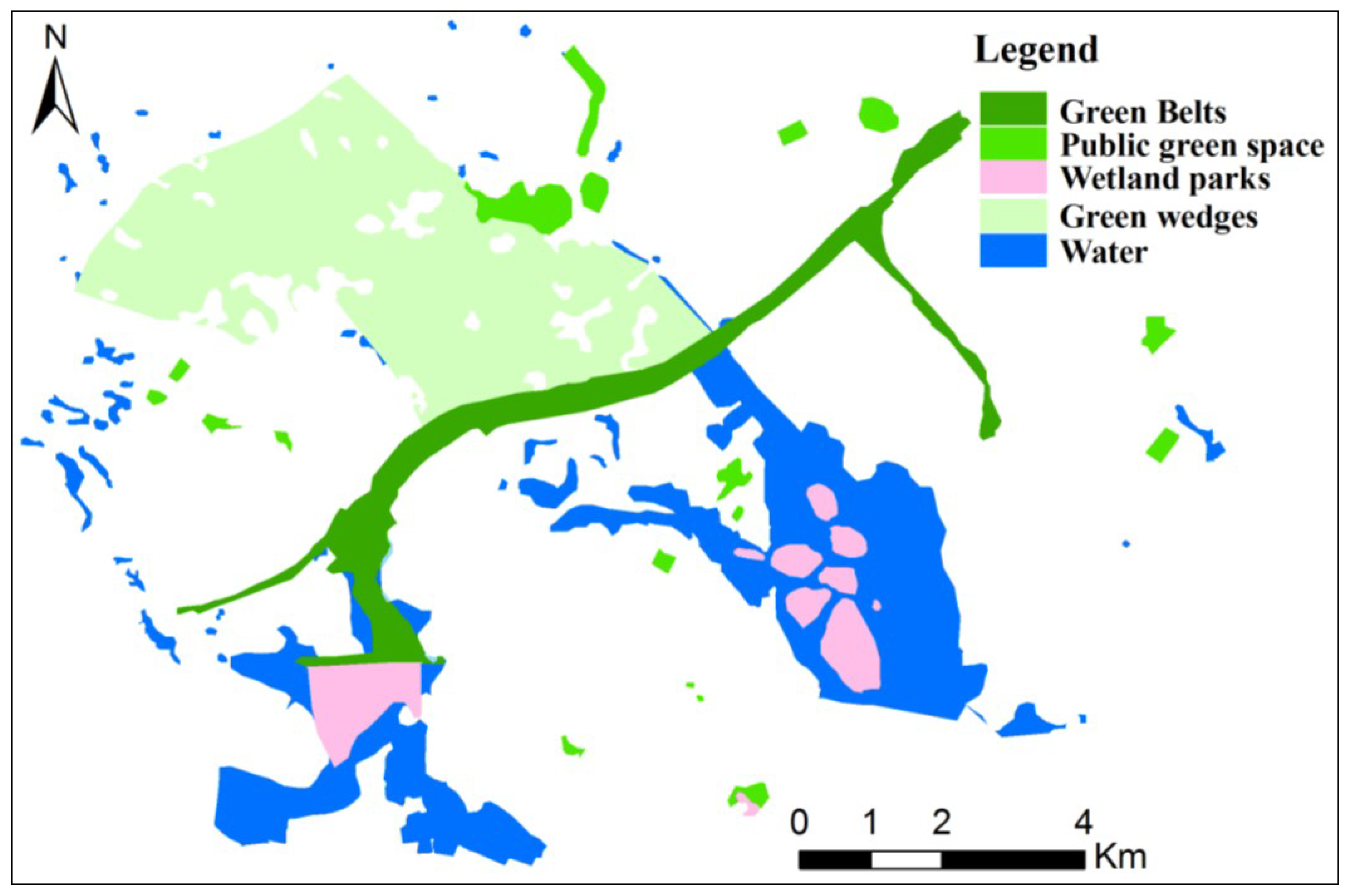
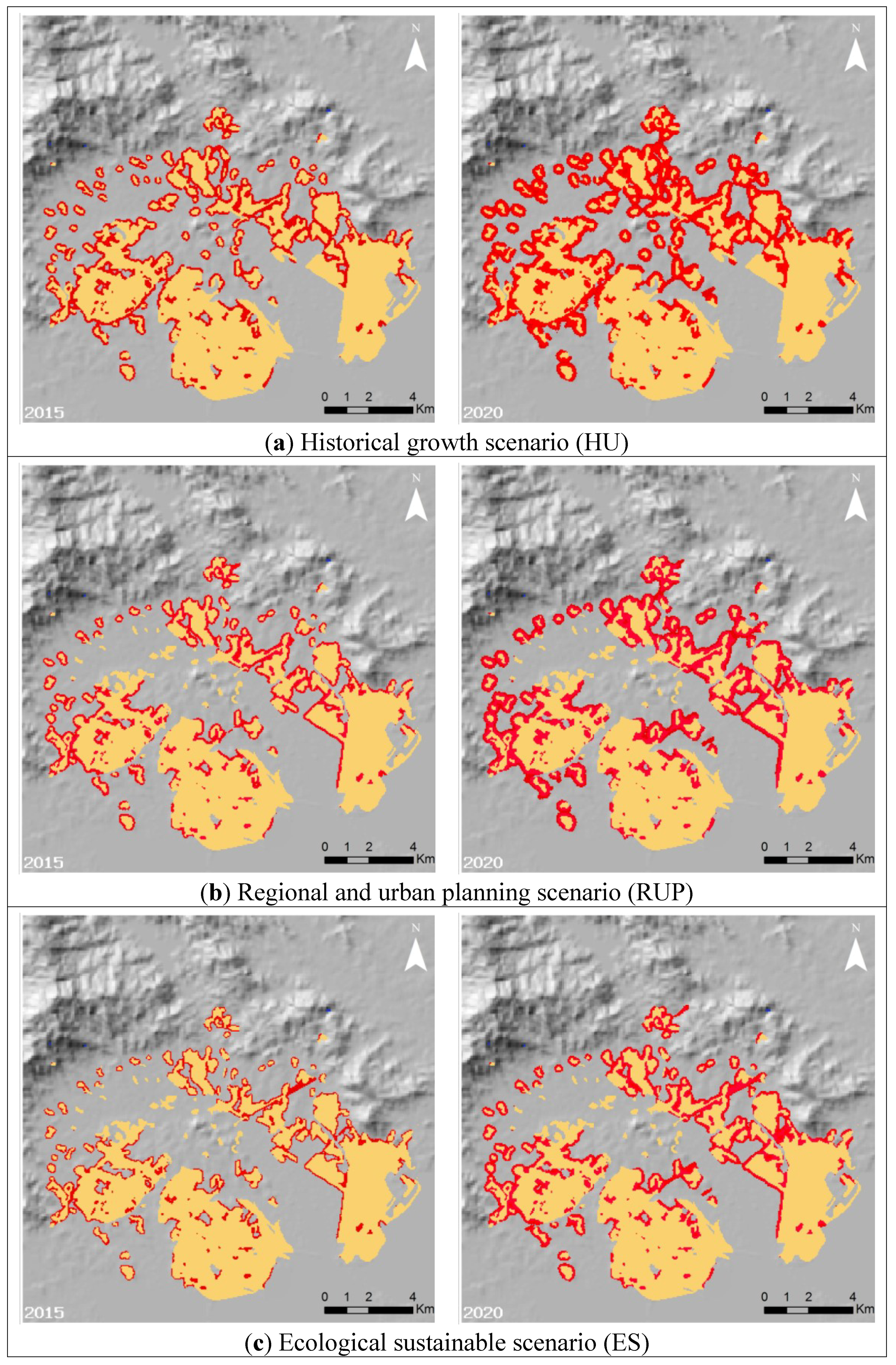
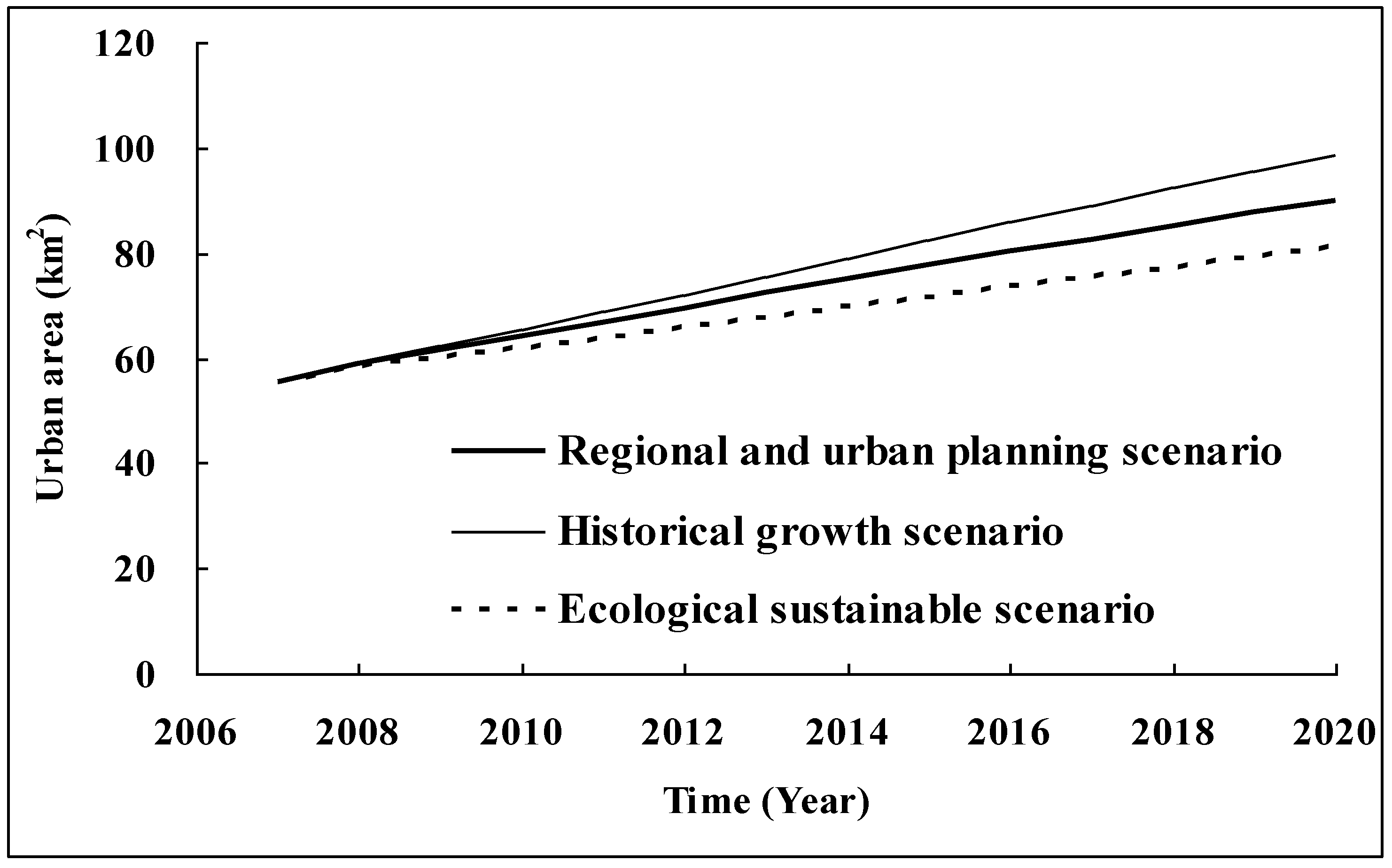
4. Summary and Conclusions
Acknowledgments
Author Contributions
Conflict of Interest
References
- Alig, R.J.; Healy, R.G. Urban and built-up land area changes in the United States: An empirical investigates of determinants. Land Econ. 1987, 63, 215–226. [Google Scholar]
- Vaz, E.; Aversa, J. A Graph theory approach for geovisualization of land use change: An application to Lisbon. J. Spat. Organ. Dyn. 2013, 1, 254–264. [Google Scholar]
- UN (United Nation). World Urbanization Prospects: The 2001 Revision; Population Division: New York, USA, 2002; p. 182. [Google Scholar]
- Makgill, R.; Rennie, H. A model for integrated coastal management legislation: A principled analysis of New Zealand’s resource management act 1991. Int. J. Mar. Coast. Law. 2012, 27, 135–165. [Google Scholar] [CrossRef]
- The United States conference of mayors. U.S. metro economies. Available online: http://www.usmayors.org/metroeconomies/2013/201311-report.pdf (accessed on 8 April 2014).
- National Bureau of Statistics of China. China Statistical Yearbook 2013; China Statistics Press: Beijing, China, 2013. [Google Scholar]
- Leao, S.Z.; Bishop, I.D.; Evans, D. Simulating urban growth in a developing nation’s region using a cellular automata-based model. J. Urban.Plan. D-ASCE 2004, 130, 145–158. [Google Scholar] [CrossRef]
- Deng, H.B.; Song, M.; Chen, C.D.; Rong, B.L. Current situation and development of Chinese urban forestry. Int. J. Sustain. Dev. World Ecol. 2008, 15, 371–377. [Google Scholar] [CrossRef]
- Vaz, E.; Walczynska, A.; Nijkamp, P. Regional challenges in tourist wetland systems: An integrated approach to the Ria Formosa in the Algarve, Portugal. Reg. Environ. Change 2013, 13, 33–42. [Google Scholar] [CrossRef]
- Ren, Y.; Yan, J.; Wei, X.; Wang, Y.; Yang, Y.; Hua, L.Z. Effects of rapid urban sprawl on urban forest carbon stocks: Integrating remotely sensed, GIS and forest inventory data. J. Environ. Manag. 2012, 113, 447–455. [Google Scholar] [CrossRef]
- Zhang, Q.; Wallace, J.; Deng, X.; Seto, K.C. Central versus local states: Which matters more in affecting China’s urban growth? Land Use Policy 2014, 38, 487–496. [Google Scholar] [CrossRef]
- Kew, B.; Lee, B.D. Measuring sprawl across the urban rural continuum using an amalgamated sprawl index. Sustainability 2013, 5, 1806–1828. [Google Scholar] [CrossRef]
- Rafiee, R.; Salman, M.A.; Khorasani, N.; Darvishsefat, A.A. Simulating urban growth in Mashad City, Iran through the SLEUTH model (UGM). Cities 2009, 26, 19–26. [Google Scholar] [CrossRef]
- Hakan, O.; Klein, A.G.; Srinivas, R. Using the SLEUTH urban growth model to simulate the impacts of future policy scenarios on urban land use in the Houston-Galveston-Brazoria CMSA. Res. J. Soc. Sci. 2007, 2, 72–82. [Google Scholar]
- Xiamen Municipal Statistical Bureau of China. Xiamen Special Economic Zone Yearbook 2013; China Statistics Press: Beijing, China, 2013. [Google Scholar]
- Yang, X. Satellite monitoring of urban spatial growth in the Atlanta metropolitan area. Photogramm. Eng. Rem. Sens. 2002, 68, 725–734. [Google Scholar]
- Silva, E.A.; Clarke, K.C. Calibration of the SLEUTH urban growth model for Lisbon and Porto, Spain. Comput. Environ. Urban Syst. 2002, 26, 525–552. [Google Scholar] [CrossRef]
- Pijanowskia, B.C.; Brown, D.G.; Shellitoc, B.A.; Manikd, G.A. Using neural networks and GIS to forecast land use changes: A land transformation model. Comput. Environ. Urban Syst. 2002, 26, 553–575. [Google Scholar] [CrossRef]
- Cheng, J.; Masser, I. Urban growth pattern modelling: A case study of Wuhan city, PR China. Landsc. Urban Plann. 2003, 62, 199–217. [Google Scholar] [CrossRef]
- Benenson, I. Multi-agent simulations of residential dynamics in the city. Comput. Environ. Urban Syst. 1998, 22, 25–42. [Google Scholar] [CrossRef]
- Veldkamp, A.; Lambin, E.F. Editorial: Predicting land-use change. Agr. Ecosys. Environ. 2001, 85, 1–6. [Google Scholar] [CrossRef]
- Liao, J.F.; Tang, L.N.; Shao, G.F.; Qiu, Q.Y.; Wang, C.P.; Zheng, S.N.; Su, X.D. A neighbor decay cellular automata approach for simulating urban expansion based on particle swarm intelligence. Int. J. Geogr. Inf. Sci. 2014, 28, 720–738. [Google Scholar] [CrossRef]
- Kityuttachai, K.; Tripathi, N.K.; Tipdecho, T.; Shrestha, R. CA-Markov analysis of constrained coastal urban growth modeling: Hua Hin seaside city, Thailand. Sustainability 2013, 5, 1480–1500. [Google Scholar] [CrossRef]
- Liu, M.; Hu, Y.M.; Li, C.L.; Sun, F.Y.; Xu, Y.Y.; Chen, T. Combining CLUE-S and SWAT models to forecast land use change and non-point source pollution impact at a watershed scale in Liaoning province, China. Chinese Geogr. Sci. 2014, 24, 1–11. [Google Scholar] [CrossRef]
- Couclelis, H. Cellular worlds: A framework for modelling micromacro dynamics. Environ. Plann. A 1985, 17, 585–596. [Google Scholar]
- Couclelis, H. Macrostructure and microbehavior in a metropolitan area. Environ. Plann. B Plann. Des. 1989, 16, 141–154. [Google Scholar]
- Clarke, K.C.; Hoppen, S.; Gaydos, L. A self-modifying cellular automaton model of historical urbanization in the San Francisco Bay area. Environ. Plann. B Plann. Des. 1997, 24, 247–261. [Google Scholar]
- Xie, Y.C. A generalized model for cellular urban dynamics. Geogr. Anal. 1997, 28, 350–373. [Google Scholar] [CrossRef]
- Wu, F.; Webster, C.J. Simulating artificial cities in a GIS environment: Urban growth under alternative regulation regimes. Int. J. Geogr. Inf. Sci. 2000, 14, 625–648. [Google Scholar] [CrossRef]
- Ligtenberg, A.; Bregt, A.K.; Lammeren, R.V. Multi-actor-based land use modeling: Spatial planning using agents. Landsc. Urban Plann. 2001, 56, 21–33. [Google Scholar] [CrossRef]
- Zhou, C.H.; Sun, Z.H.; Xie, Y.C. The Research of Geographical Cellular Automata; Science Press: Beijing, China, 1999; pp. 1–163. [Google Scholar]
- Shi, W.; Pang, M.Y. Development of Voronoi-based cellular automata -an integrated dynamic model for Geographical. Int. J. Geogr. Inf. Sci. 2000, 14, 455–474. [Google Scholar] [CrossRef]
- Vaz, E.; Caetano, M.; Nijkamp, P.; Painho, M. A multi-scenario forecast of urban change: A study on urban growth in the Algarve. Landsc. Urban Plann. 2012, 104, 201–211. [Google Scholar] [CrossRef]
- Batty, M.; Xie, Y.C.; Sun, Z.L. Modelling urban dynamics through GIS-based cellular automata. Comput. Environ. Urban Syst. 1999, 23, 205–233. [Google Scholar] [CrossRef]
- Wu, F. Calibration of stochastic cellular automata: The application to rural-urban land conversions. Int. J Geogr. Inf. Sci. 2002, 16, 795–818. [Google Scholar] [CrossRef]
- Ménard, A.; Marceau, D.J. Exploration of spatial scale sensitivity in geographical cellular automata. Environ. Plann. B Plann. Des. 2005, 32, 693–714. [Google Scholar] [CrossRef]
- Liu, X.P.; Li, X.; Liu, L. A bottom-up approach to discover transition rules of cellular automata using ant intelligence. Int. J Geogr. Inf. Sci. 2008, 22, 1247–1269. [Google Scholar] [CrossRef]
- Silva, E.A. The DNA of our regions: Artificial intelligence in regional planning. Futures 2004, 36, 1077–1094. [Google Scholar] [CrossRef]
- Arthur, S.T.; Carlson, T.N.; Ripley, D.A. Land use dynamics of Chester county, Pennsylvania, from a satellite remote sensing perspective. Geocarto Int. 2000, 15, 25–35. [Google Scholar]
- Claggett, P.; Jantz, C.A.; Goetz, S.J.; Bisland, C. Assessing development pressure in the Chesapeake Bay watershed: An evaluation of two land-use change models. Environ. Monit. Assess. 2004, 94, 129–146. [Google Scholar] [CrossRef]
- Yang, X.; Lo, C.P. Modelling urban growth and landscape change in the Atlanta metropolitan area. Int. J. Geogr. Inform. Sci. 2003, 17, 463–488. [Google Scholar] [CrossRef]
- Dietzel, C.K.; Clarke, K.C. The effect of disaggregating land use categories in cellular automata during model calibration and forecasting. Comput. Environ. Urban. Syst. 2006, 30, 78–101. [Google Scholar]
- Jantz, C.A.; Goetz, S.J.; Donato, D; Claggett, P. Designing and implementing a regional urban modeling system using the SLEUTH cellular urban model. Comput. Environ. UrbanSyst. 2010, 34, 1–16. [Google Scholar]
- Syphard, A.D.; Clarke, K.C.; Franklin, J.; Regan, H.M.; Mcginnis, M. Forecasts of habitat loss and fragmentation due to urban growth are sensitive to source of input data. J. Environ. Manag. 2011, 92, 1882–1893. [Google Scholar] [CrossRef]
- Hua, L.Z.; Li, X.Q.; Tang, L.N.; Yin, K.; Zhao, Y. Spatio-temporal dynamic analysis of island-city landscape: A case study of Xiamen Island, China. Int. J. Sustain. Dev. World Ecol. 2010, 17, 273–278. [Google Scholar] [CrossRef]
- Hua, L.Z.; Cui, S.H.; Huang, Y.F.; Yin, K.; Xiong, Y.Z. Analyses of Peri-Urban landscape dynamics in the rapid urbanizing process: A case study of Xiamen. Acta Ecol. Sin. 2009, 29, 3509–3517. [Google Scholar]
- Tang, L.N.; Zhao, Y.; Yin, K.; Zhao, J. City profile: Xiamen. Cities 2013, 31, 615–624. [Google Scholar] [CrossRef]
- Sangawongse, S.; Sun, C.H.; Tsai, B.W. Urban growth and land cover change in Chiang Mai and Taipei: Results from the SLEUTH model. In Proceedings of the MODSIM 2005 International Congress on Modelling and Simulation, Melbourne, Australia, 12-15 December 2005; Zerger, A., Argent, R.M., Eds.; The Modelling and Simulation Society of Australia and New Zealand: Hobart, Australia.
- Dietzel, C.K.; Clarke, K.C. Toward optimal calibration of the SLEUTH land use change model. Trans. GIS. 2007, 11, 29–45. [Google Scholar]
- Ding, Y.C.; Zhang, Y.K. The simulation of urban growth applying SLETUH CA model to the Yilan DELTA in Taiwan. Jurnal Alam Bina 2007, 9, 95–107. [Google Scholar]
- Clarke, K.C.; Gaydos, L.J. Loose coupling a cellular automaton model and GIS: Long-term urban growth prediction for San Francisco and Washington/Baltimore. Int. J. Geogr. Inform. Sci. 1998, 12, 699–714. [Google Scholar] [CrossRef]
- Hakan, O.; Klein, A.G.; Srinivas, R. Calibration of the SLEUTH model based on the historic growth of Houston. J. AppliedSci. 2007, 7, 1843–1853. [Google Scholar]
- Jantz, C.A.; Goetz, S.J.; Shelley, M.K. Using the SLEUTH urban growth model to simulate the impacts of future policy scenarios on urban land use in the Baltimore-Washington Metropolitan Area. Environ. Plann. BPlann. Des. 2003, 31, 251–271. [Google Scholar] [CrossRef]
- Clarke, K.C.; Gazulis, N.; Dietzel, C.K.; Goldstein, N.C. A decade of SLEUTHing: Lessons learned from applications of a cellular automaton land use change model. In Classics from IJGIS: Twenty Years of the International Journal of Geographical Information Systems and Science; Fisher, P., Ed.; Taylor and Francis: Boca Raton, USA, 2007; pp. 413–425. [Google Scholar]
© 2014 by the authors; licensee MDPI, Basel, Switzerland. This article is an open access article distributed under the terms and conditions of the Creative Commons Attribution license (http://creativecommons.org/licenses/by/3.0/).
Share and Cite
Hua, L.; Tang, L.; Cui, S.; Yin, K. Simulating Urban Growth Using the SLEUTH Model in a Coastal Peri-Urban District in China. Sustainability 2014, 6, 3899-3914. https://doi.org/10.3390/su6063899
Hua L, Tang L, Cui S, Yin K. Simulating Urban Growth Using the SLEUTH Model in a Coastal Peri-Urban District in China. Sustainability. 2014; 6(6):3899-3914. https://doi.org/10.3390/su6063899
Chicago/Turabian StyleHua, Lizhong, Lina Tang, Shenghui Cui, and Kai Yin. 2014. "Simulating Urban Growth Using the SLEUTH Model in a Coastal Peri-Urban District in China" Sustainability 6, no. 6: 3899-3914. https://doi.org/10.3390/su6063899
APA StyleHua, L., Tang, L., Cui, S., & Yin, K. (2014). Simulating Urban Growth Using the SLEUTH Model in a Coastal Peri-Urban District in China. Sustainability, 6(6), 3899-3914. https://doi.org/10.3390/su6063899






